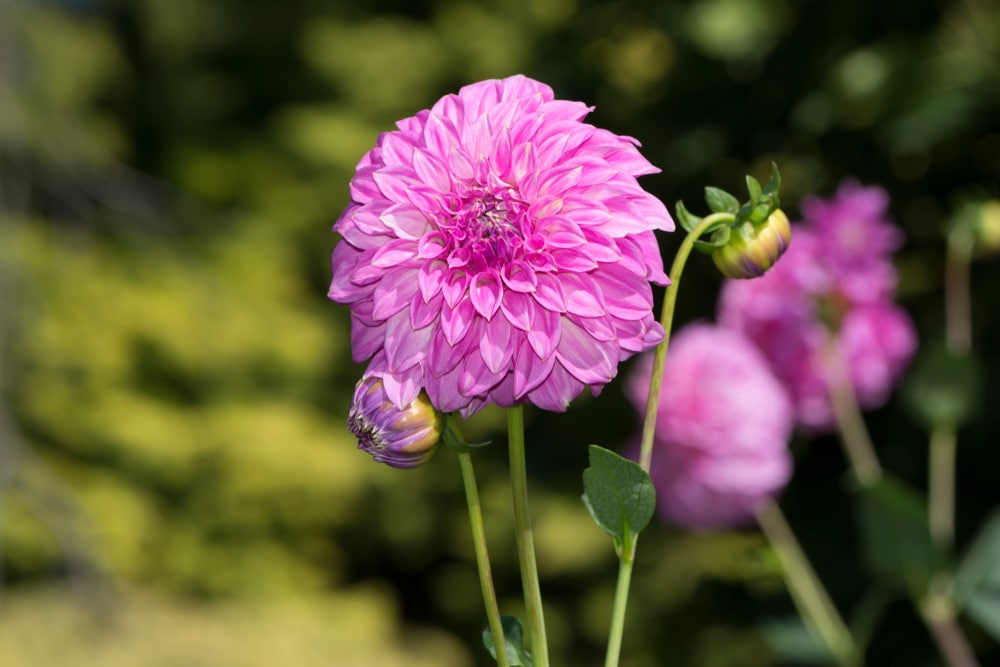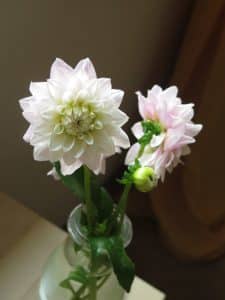The Dahlia Bracken Rose is a variety of the ever-stunning Dahlia flower. This beautiful bloom has all the layers, size, and fullness of a Peony with a more uniform, impressive petal spread. If you’re looking for a true winner for a bouquet, the Bracken Rose is your next go-to.
| Botanical Name | Dahlia spp. |
| Common Name | Dahlia |
| Plant Type | Herbaceous Perennial |
| Flower Color | Medium Blooms in Pink, Dusty Rose |
| Size When Mature | 1 to 3 ft. Spread |
| Bloom Time | Summer, Fall |
| Sun Requirements | Full Sun |
| USDA Hardiness Zones | 8 – 10 |
| Soil PH Range | Acidic or Neutral |
| Soil Type | Loamy, Well-Drained |
| Water Needs | Average |
| Native Area | Mexico, Central America |
What You Need To Know About the Dahlia Bracken Rose
The Dahlia Bracken Rose is a specific variety of Dahlia, which comes from the Asteraceae family. The family includes other well-loved flowers like Sunflowers, Daisies, and Zinnias.
This particular variety of herbaceous perennial blooms in a gorgeous dusty rose or pink color. The flowers are round and medium-sized and boast layers of eye-catching tubular petals. They bloom throughout the summer and fall and can produce an impressive number of flowers.
Dahlias make excellent cut flowers. In fact, cutting their blooms will encourage more growth. Cut flowers last about a week in bouquets and vases.
How To Care for the Dahlia Bracken Rose
Here’s everything you need to know about growing and caring for a thriving Dahlia Bracken Rose.
Light
To get the most out of your Bracken Roses, place them in a location where they receive full sun – at least six hours per day. If you’re in a very warm climate, try to put them somewhere they can get a little shade relief in the afternoon.
Water and Soil Needs
It’s best to plant Dahlia Bracken Roses in the spring. Unlike many other plants, Dahlias don’t require water to integrate into the dirt. Because they’re tubular, they need time before water so their root systems can develop.
But once the plant starts to sprout, you can water it once or twice weekly. Increase watering in hot areas or on particularly hot days.
Dahlias do well in rich, well-draining soil. For better drainage, you can add sand or peat moss to dense, clay soil.
Temperature Requirements
Dahlia Bracken Roses are cold hardy flowers and do best in USDA zones 8 to 11. However, dedicated gardeners can keep them thriving in zones 6 or 7.
The flower prefers moderate climates. In colder areas, these flowers function better as annuals – though you can dig them up and keep them inside during the winter to replant after the last frost.
In moist, moderate areas, these tubers keep well in the soil and remain perennials.
Fertilizer
If you want your Dahlia to bloom large and frequently, invest in a good phosphorus fertilizer. 10-30-20 ratios work well to promote blooming, and your plant will feast on it. Avoid high-nitrogen fertilizers, as these will decrease the number of flowers you get.
Common Diseases
Various varieties of Dahlia, including the Bracken Rose, are prone to fungal diseases. In particular, Dahlias can get powdery mildew due to excess moisture.
The best way to avoid this is to keep the foliage dry and only water the plant at the root. It also helps to plant multiples spaced out to allow for proper airflow. The plant can also be affected by insect pests.
Dahlia Bracken Rose Propagation
Dahlia propagation works best in one of two ways: from cuttings or overwintered tubers. Once your Dahlias sprout in the spring, you can propagate the cuttings by cutting just beneath the sprout, partly into the tuber.
Trim all the lower leaves and pot the cuttings indoors until they’re well-rooted and the weather is warm enough to plant outside.
To propagate using overwintered tubers, gather clumps of tubers and choose ones with eyes. Lay each horizontally in a pot of soil 2 to 3 inches deep and keep the pot in a sunny place until they sprout.


